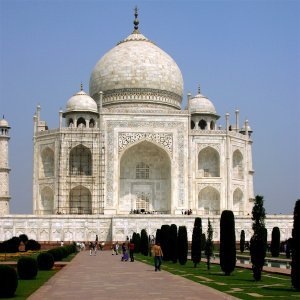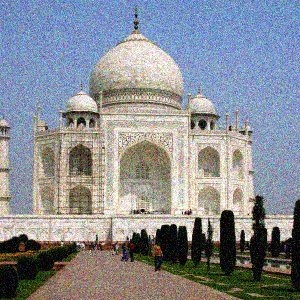| 7.6. Zgomot RGB | ||
|---|---|---|

|
7. Filtre de zgomot |  |
Fig. 17.158. Exemplu de aplicare a filtrului „Zgomot RGB”

Imagine originală

Filtru „Zgomot RGB” aplicat
The RGB Noise filter adds a normally distributed noise to a layer or a selection. It uses the RGB color model to produce the noise (noise is added to red, green and blue values of each pixel). A normal distribution means, that only slight noise is added to the most pixels in the affected area, while less pixels are affected by more extreme values. (If you apply this filter to an image filled with a solid gray color and then look at its histogram, you will see a classic bell-shaped Gaussian curve.)
Rezultatul este foarte natural ca zgomot.
![[Notă]](images/note.png)
|
Notă |
|---|---|
|
Aceste opțiuni sunt descrise în Secțiune 2, „Caracteristici obișnuite”. |
Noise may be additive (uncorrelated) or multiplicative (correlated - also known as speckle noise). When checked, every channel value is multiplied by a normal distributed value. So the noise depends on the channel values: a greater channel value leads to more noise, while dark colors (small values) tend to remain dark.
When this radio button is checked, you can move each RGB slider separately. Otherwise, the sliders R, G and B will be replaced by a single slider Value. The same relative noise will then be added to all channels in each pixel, so the hue of pixels does not change much.
Operează pe date de culoare liniare RGB.
Utilizează o distribuție de zgomot gaussian. Când este debifat, o distribuție liniară de zgomot este folosită în loc.
These slidebars and adjacent input boxes allow to set noise level (0.00 - 1.00) in each channel.
Valoarea stabilită de aceste glisoare determină de fapt deviația standard a distribuției normale a zgomotului aplicat. Deviația standard utilizată este jumătate din valoarea stabilită (unde 1 este distanța dintre cea mai mică și cea mai mare valoare posibilă dintr-un canal).
Controls randomness of noise. If the same random seed is used in the same situation, the filter produces exactly the same results. A different random seed produces different results. Random seed can be entered manually or generated randomly by pressing the button.